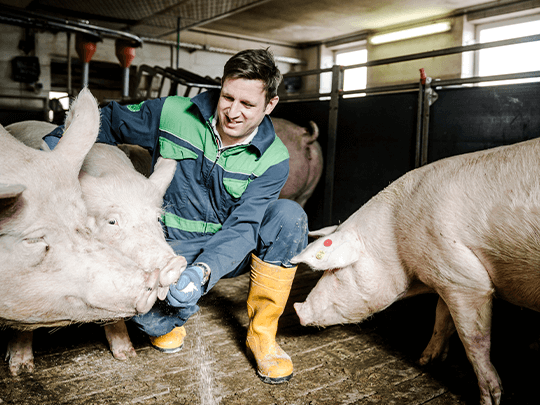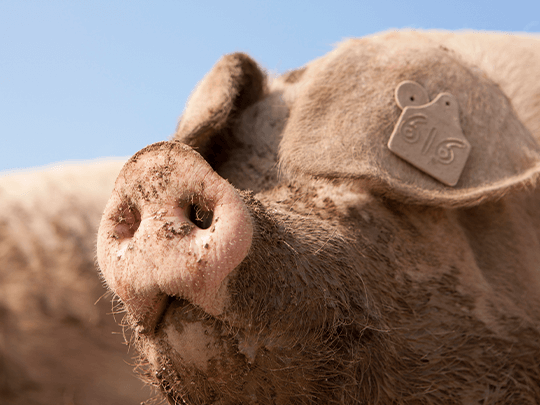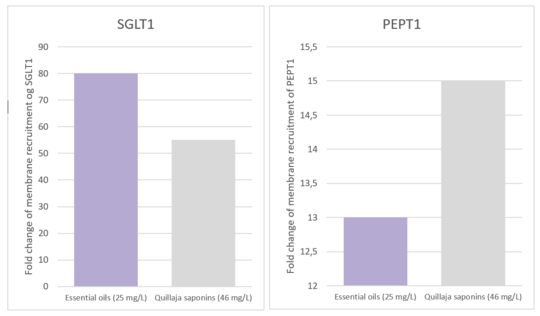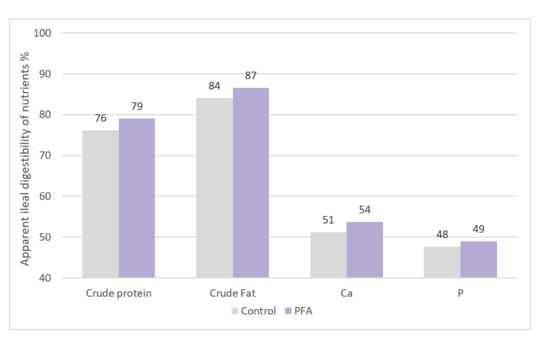Improve feed efficiency in pigs with the power of nature
In recent months, practically all feed ingredients have suffered a massive increase in their prices, causing economic issues to the short and long term of pig production. Several management decisions can be undertaken to reduce feed costs, like lowering the slaughter weight, implementing multi-phase feeding programs, and changing to pelleted feed. These are good examples of what can be done to impact feed efficiency and save feed costs positively. Beyond, this time we'd like to give you some insights on how you can save feed costs with the help of phytogenics.
Two ways to improve the FCR:
Looking at the feed conversion ratio (FCR), as the kg of feed consumed to produce 1 kg of body gain, we can see how it is directly linked to the feed cost per kg of body weight gain or raised pig. From a practical perspective, there are two possible ways to improve the FCR:

Less feed for the same weight gain
The first approach is to provide less feed to the animals; however, this alternative can be somewhat risky once it may damage performance, impairing animal growth. To be effective, it is suggested to change the diet's nutritional content. Pig's feed intake is related to the energy level of the diet. Increasing the energy level per kg of feed will fulfill the animal's energy requirement with less ingested feed.
This seems simple and effective…but as the nutritionist increases the dietary energy concentration, all other nutrients will have to grow too, lysine and all amino acids in ratio with lysine, minerals, etc. We must ensure that a reduced feed intake is still meeting all nutritional requirements of the animals for maintenance and growth, according to their potential (animals' needs are expressed in quantities of each nutrient per day according to genetics, gender, and production phase/age/weight). The hard reality is that a dietary nutritional concentration is expensive, the cost per kg of feed increases, and most of the time, even if a reduced FCR is achieved, the feed cost per pig stays the same or is even higher

Same feed and more weight gain
The second option assumes that for the same feed intake, more body weight gain can be generated. It is doubtful that animals enhance body weight gain because it's needed. Sometimes, the animals' growth potential is limited by compromising factors, like sanitary conditions, environment, density, or other constraints. So special attention should be given to those factors to provide the pigs with the best conditions to perform. When those limitations are already removed and are non-existing, the growth potential of pigs can be exploited better. Still, producers can use available scientifically proven solutions to improve pig's growth, optimize feed efficiency and reduce feeding costs.
Make the change happen
Feed efficiency is no more than the expression of the capacity of the animal to transform the ingested ingredients into mass body gain. Some processes like ingestion, digestion, and absorption affect the efficiency rate in the pathway. Specific and chosen phytogenic compounds exert a stimulatory action on the secretion of the animal's digestive endogenous enzymes and, at the same time, slightly reduce the digesta transit time. Both effects allow more enzymatic action on the ingredients, breaking them down to nutrients and a little more time is available for the enzymatic processes to be more effective. The intestinal cell layer is guarded on its morphology and physiology by the antioxidant and anti-inflammatory properties of the plant compounds reflected on preserved and functional absorptive enterocytes.

In addition, a study (see figure 1, Reyer et al., 2017) has demonstrated the positive effect of essential oils and saponins on the recruitment of nutrient transporters like the peptide transporter 1 (PEPT1) and the sodium-glucose transporter (SGLT1). In summary, more nutrients in the intestinal lumen can be absorbed by functional enterocytes, which express more nutrient transporters, allowing extra nutrient uptake and further metabolization.
Use nature to save on feed costs
Adding Delacon's selected plant bio-actives to a growing/finishing pigs' existing diet improves feed efficiency, and the animals respond with higher performance. The FCR has been reduced, and thus the feed costs per kg body weight, too. However, vital measures should be taken in specific scenarios, like when diet ingredients prices are high, impacting feed price directly, causing cash flow and even profitability losses to producers.
For all situations where feed price reduction is the target, Delacon developed the Performizer® solution by which feeding costs are immediately reduced, maintaining the same animal's performance.

This natural solution is based on the results of ileal nutrient digestibility studies, where diet's nutrient digestibility is measured and compared, allowing a quantification of the feed efficiency generated when the phytogenic solution is added to a diet (see figure 2). Those nutrient digestibility enhancements are transposed to nutrient matrix values and applied on least-cost feed optimization (formulation).
The Performizer® solution is a natural, safe and very convenient tool that, when applied on least-cost feed formulation/optimization, leads to an immediate saving on feed costs in pig production.

Sandra Chamusco
Global Technical Manager Swine at Delacon Sandra Chamusco has a degree in Animal Science at the University of Évora in Portugal and has been working in swine nutrition for more than 20 years. She was a feed formulator and customer consultant, technical responsible and Director of Operations at the Portuguese subsidiary of the French group CCPA. After that she was Director of Swine Nutrition Department at T.N.A. (Portugal). At Delacon,Sandra is responsible for product development and product support, and for the customer technical services for the complete range of Delacon’s swine products on a global level.










